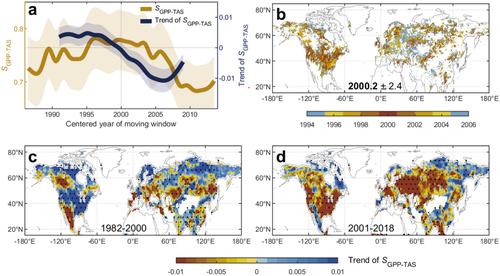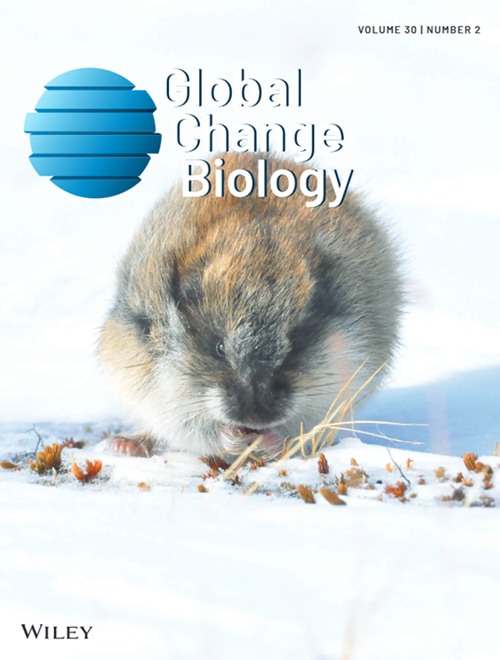Drought-Induced Weakening of Temperature Control on Ecosystem Carbon Uptake Across Northern Lands
IF 10.8
1区 环境科学与生态学
Q1 BIODIVERSITY CONSERVATION
引用次数: 0
Abstract
Rapid warming in northern lands has led to increased ecosystem carbon uptake. It remains unclear, however, whether and how the beneficial effects of warming on carbon uptake will continue with climate change. Moreover, the role played by water stress in temperature control on ecosystem carbon uptake remains highly uncertain. Here, we systematically explored the trend in the temperature control on gross primary production (measured by “SGPP-TAS”) across northern lands (> 15°N) using a standardized multiple regression approach by controlling other covarying factors. We estimated SGPP-TAS using three types of GPP datasets: four satellite-derived GPP datasets, FLUXNET tower observed GPP datasets, and GPP outputs from nine CMIP6 models. Our analysis revealed a significant positive-to-negative transition around the year 2000 in the trend of SGPP-TAS. This transition was primarily driven by synchronized changes in soil water content over time and space. The SGPP-TAS trend transition covered about 32% of northern lands, especially in grasslands and coniferous forests where leaf water mediation and structural overshoot accelerated the drought-induced transition, respectively. In the future, widespread negative SGPP-TAS trends are projected in northern lands corresponding with decreasing soil water availability. These findings highlight the shrinking temperature control on northern land carbon uptake in a warmer and drier climate.

干旱对北方土地生态系统碳吸收的温度控制减弱
北方土地的快速变暖导致生态系统碳吸收增加。然而,目前尚不清楚,气候变暖对碳吸收的有益影响是否以及如何随着气候变化而继续。此外,水分胁迫在温度控制中对生态系统碳吸收的作用仍然高度不确定。本文通过控制其他协变因素,采用标准化多元回归方法,系统探讨了温度控制对北方土地(> 15°N)初级生产总值(以“SGPP-TAS”测量)的影响趋势。我们使用三种类型的GPP数据集来估计GPP- tas:四种卫星衍生的GPP数据集,FLUXNET塔观测的GPP数据集,以及来自9个CMIP6模型的GPP输出。我们的分析显示,在2000年前后,sgp - tas的趋势出现了显著的正向负转变。这种转变主要是由土壤含水量随时间和空间的同步变化驱动的。sgp - tas趋势转变覆盖了32%的北方土地,特别是在草原和针叶林,叶水调解和结构超调分别加速了干旱诱导的转变。在未来,预计北方土地SGPP-TAS普遍呈负趋势,与土壤水分有效性下降相对应。这些发现强调了在更温暖、更干燥的气候下,温度对北方陆地碳吸收的控制正在减弱。
本文章由计算机程序翻译,如有差异,请以英文原文为准。
求助全文
约1分钟内获得全文
求助全文
来源期刊

Global Change Biology
环境科学-环境科学
CiteScore
21.50
自引率
5.20%
发文量
497
审稿时长
3.3 months
期刊介绍:
Global Change Biology is an environmental change journal committed to shaping the future and addressing the world's most pressing challenges, including sustainability, climate change, environmental protection, food and water safety, and global health.
Dedicated to fostering a profound understanding of the impacts of global change on biological systems and offering innovative solutions, the journal publishes a diverse range of content, including primary research articles, technical advances, research reviews, reports, opinions, perspectives, commentaries, and letters. Starting with the 2024 volume, Global Change Biology will transition to an online-only format, enhancing accessibility and contributing to the evolution of scholarly communication.
 求助内容:
求助内容: 应助结果提醒方式:
应助结果提醒方式:


